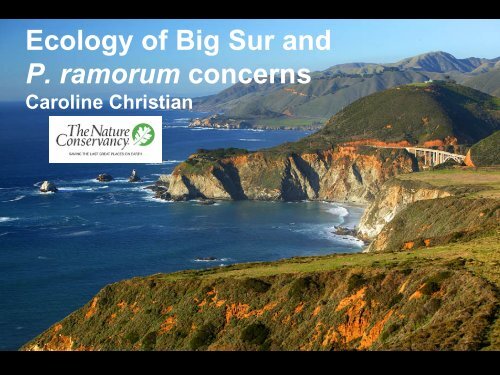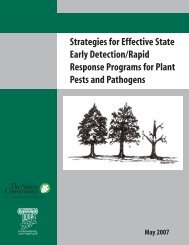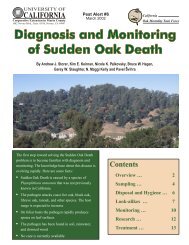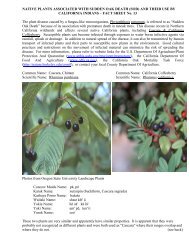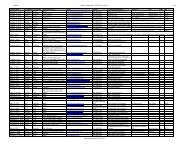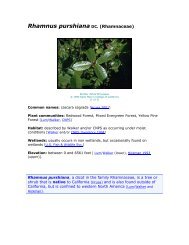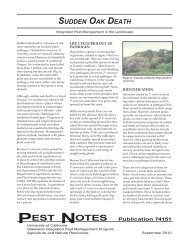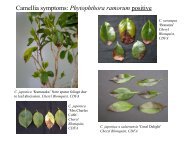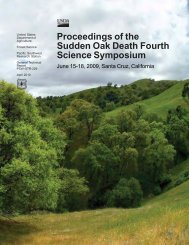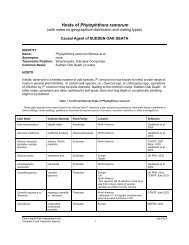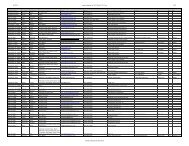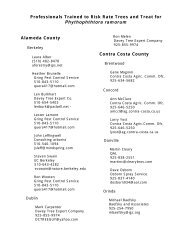Ecology of Big Sur and P. ramorum concerns - Sudden Oak Death
Ecology of Big Sur and P. ramorum concerns - Sudden Oak Death
Ecology of Big Sur and P. ramorum concerns - Sudden Oak Death
- No tags were found...
Create successful ePaper yourself
Turn your PDF publications into a flip-book with our unique Google optimized e-Paper software.
<strong>Ecology</strong> <strong>of</strong> <strong>Big</strong> <strong>Sur</strong> <strong>and</strong>P. <strong>ramorum</strong> <strong>concerns</strong>Caroline Christian
Overview• Overview <strong>of</strong> ecological systems in <strong>Big</strong> <strong>Sur</strong>– Systems impacted by SOD• Intersection <strong>of</strong> SOD with otherconservation threats• Conservation strategies
Conservation Action Planning• What is CAP?Project in <strong>Big</strong> <strong>Sur</strong>– Adaptive management tool• Who is involved?– Multi-partner effort• BSLT, TNC, MPRPD, USFS, CDFG, SLLC,ESNERR, UC NRS, various local experts• What is the scope <strong>of</strong> the project?– Western slope <strong>of</strong> Santa Lucia range fromCarmel River to San Simeon
CAP Overview• What is the biodiversity we care about <strong>and</strong>what is our best estimate <strong>of</strong> how it’s doing?• What are the threats to biodiversity <strong>and</strong> howserious are they?• What specific outcomes are we trying toachieve <strong>and</strong> what actions are needed toachieve them?• How do we know if our actions are working?
Summary <strong>of</strong> CAP projectSystemsTargets & ViabilityStresses & SourcesCritical ThreatsImplement &MonitorAdapt & LearnSuccessMonitoring PlanAnalyze &CommunicateStrategiesObjectivesAction Plan
What is the biodiversity we care about <strong>and</strong>what is our best estimate <strong>of</strong> how it’s doing?SystemsTargets & ViabilityStresses & SourcesCritical ThreatsImplement &MonitorAdapt & LearnSuccessMonitoring PlanAnalyze &CommunicateStrategiesObjectivesAction Plan
Target selection• Target = ecological system, community orspecies• Focus on systems that capture most <strong>of</strong> biologicaldiversity <strong>and</strong> key ecological processes• Course-filter systems– Ecological processes– Environmental features (e.g. soils, geology)– Environmental gradients (e.g. elevation, rainfall)– Many communities <strong>and</strong>/or species may be imbedded
SystemsTargets & ViabilityLocalized endemic systems<strong>Oak</strong> woodl<strong>and</strong>sWide-ranging wildlife speciesMixed evergreen/montane chaparralRiverine systemsCoastal prairie/coastal scrubNearshore terrestrial systemsFreshwater wetl<strong>and</strong>s
SystemsTargets & ViabilityLocalized endemic systems<strong>Oak</strong> woodl<strong>and</strong>sWide-ranging wildlife speciesMixed evergreen/montane chaparralRiverine systemsCoastal prairie/coastal scrubNearshore terrestrial systemsFreshwater wetl<strong>and</strong>s
Systems at risk• Coastal oak woodl<strong>and</strong>s– Coast live oak woodl<strong>and</strong> (blueoak <strong>and</strong> valley oak woodl<strong>and</strong>snot at risk)• Mixed evergreen forest– California bay forest, coast liveoak forest, douglas fir/tanoakforest, tanoak forest• Wide-ranging targets– Mountain lion, badger, bear,deer, elk, condors, etc.
What is the current condition<strong>of</strong> biodiversity in <strong>Big</strong> <strong>Sur</strong>?SystemsTargets & ViabilityStresses & SourcesCritical ThreatsImplement &MonitorAdapt & LearnSuccessMonitoring PlanAnalyze &CommunicateStrategiesObjectivesAction Plan
Assessing target ‘viability’• L<strong>and</strong>scape context– Connectivity to naturall<strong>and</strong>scapes– Intactness <strong>of</strong> ecologicalprocesses• Condition– e.g. species composition, agestructure•Size– Size/extent <strong>of</strong> community orpopulation
Viability example: <strong>Oak</strong> woodl<strong>and</strong>s
Viability <strong>of</strong> targetsaffected by SODMixed Evergreen Forest<strong>Oak</strong> Woodl<strong>and</strong>Overall Viability SummarySanta Lucia Western Slope/Lower Carmel River Valley1ConservationTargetsMixed EvergreenForest/ChaparralL<strong>and</strong>scapeContextGoodConditionPoor2 <strong>Oak</strong> Woodl<strong>and</strong> Fair PoorSizeVeryGoodVeryGoodViabilityRankFairFair3 Wide-ranging wildlife Fair Good Good GoodOverall Biodiversity Health RankFairWide-ranging Species
What are the threats to biodiversity<strong>and</strong> how serious are they?SystemsTargets & ViabilityStresses & SourcesCritical ThreatsImplement &MonitorAdapt & LearnSuccessMonitoring PlanAnalyze &CommunicateStrategiesObjectivesAction Plan
Assessing threats to targets• Threats <strong>and</strong> their drivers– e.g. fragmentation is threat, rural residentialdevelopment <strong>and</strong> roads are the drivers• Scope <strong>and</strong> severity– spatial extent <strong>of</strong> threat <strong>and</strong> its severity• Quartile ranking– Very high, high, medium, low
Threats to <strong>Big</strong> <strong>Sur</strong>Altered fire regimeInvasive pathogensLack <strong>of</strong> educationRural residentialdevelopmentInvasive plantsInvasive animalsRoads <strong>and</strong> trailsInappropriategrazing regimeSedimentation
SOD is top threat to <strong>Big</strong> <strong>Sur</strong>
Relationship among threatsAltered fire regimeInvasiveplantsInappropriategrazing regimeRural residentialdevelopment?P. <strong>ramorum</strong>?SedimentationLack <strong>of</strong>educationInvasiveanimalsRoads<strong>and</strong> trails
Relationship among threatsAltered fire regimeInvasiveplantsInappropriategrazing regimeRural residentialdevelopment?P. <strong>ramorum</strong>?SedimentationLack <strong>of</strong>educationInvasiveanimalsRoads<strong>and</strong> trails
Relationship among threatsAltered fire regimeInvasiveplantsInappropriategrazing regimeRural residentialdevelopment?P. <strong>ramorum</strong>?SedimentationLack <strong>of</strong>educationInvasiveanimalsRoads<strong>and</strong> trails
Relationship among threatsAltered fire regimeInvasiveplantsInappropriategrazing regimeRural residentialdevelopment?P. <strong>ramorum</strong>?SedimentationLack <strong>of</strong>educationInvasiveanimalsRoads<strong>and</strong> trails
Relationship among threatsAltered fire regimeInvasiveplantsInappropriategrazing regimeRural residentialdevelopment?P. <strong>ramorum</strong>?SedimentationLack <strong>of</strong>educationInvasiveanimalsRoads<strong>and</strong> trails
Relationship among threatsAltered fire regimeInvasiveplantsInappropriategrazing regimeRural residentialdevelopment?P. <strong>ramorum</strong>?SedimentationLack <strong>of</strong>educationInvasiveanimalsRoads<strong>and</strong> trails
Efforts to manage SODe.g. thinning, burningAltered fire regimeInvasiveplantsInappropriategrazing regimeRural residentialdevelopment?P. <strong>ramorum</strong>?SedimentationLack <strong>of</strong>educationInvasiveanimalsRoads<strong>and</strong> trails
Efforts to manage SODe.g. thinning, burningAltered fire regimeInvasiveplantsInappropriategrazing regimeRural residentialdevelopment?P. <strong>ramorum</strong>?SedimentationLack <strong>of</strong>educationInvasiveanimalsRoads<strong>and</strong> trails
What specific outcomes are we trying to achieve<strong>and</strong> what actions are needed to achieve them?SystemsTargets & ViabilityStresses & SourcesCritical ThreatsImplement &MonitorAdapt & LearnSuccessMonitoring PlanAnalyze &CommunicateStrategiesObjectivesAction Plan
Conservation strategies• Research <strong>and</strong> management• Conservation planning• Education <strong>and</strong> outreach
Research <strong>and</strong> Management• Cascading ecological effects– Which species are at greatest risk?• Rare <strong>and</strong> common species• Different taxa– Non-linear effects• Tough to measure• Efficacy <strong>of</strong> management options– Fire, thinning, chemical treatments, etc.• Unintended consequences <strong>of</strong> management– e.g. Disturbance may facilitate plant/animal invasion
Conservation planning• Preserve at-risk ecological communities <strong>and</strong>species across broad geographic range– Captures range <strong>of</strong> genetic diversity• Maintain large, connected l<strong>and</strong>scapes– Minimizes further roads, fragmentation, humanmovement <strong>of</strong> pathogen– Increases flexibility for large-scale management• e.g. prescribed fire <strong>and</strong> wildfire
Palo Corona Ranch• Unites 13protected areas• 7 agencies/l<strong>and</strong>trusts• ManagementMOU
Engage <strong>and</strong> educate l<strong>and</strong>managers• Get l<strong>and</strong> managers more involved• Determine <strong>concerns</strong>– How are managers addressing P. <strong>ramorum</strong>?– What are information needs?• Encourage education <strong>of</strong> public– Human-mediated spread <strong>of</strong> P. <strong>ramorum</strong>–Prevention• Work with managers to develop ‘best managementpractices’ to share with larger community• Develop learning networks
How do we know if our actionsare working?SystemsTargets & ViabilityStresses & SourcesCritical ThreatsImplement &MonitorAdapt & LearnSuccessMonitoring PlanAnalyze &CommunicateStrategiesObjectivesAction Plan
Summary <strong>and</strong> conclusions• Conservation community has undergone arigorous process to identify threats to BSecosystems– SOD ranked as major threat• Threats may interact with SOD in complex ways• Management efforts may also interact with avariety <strong>of</strong> threats– Unintended consequences• Preservation <strong>of</strong> large l<strong>and</strong>scape– Maintaining flexibility to apply different managementtools is key
Special-status vertebrates in CAat risk to SODRisk Amphibians Birds Mammals ReptilesLow(0-33%)79%(31)96%(154)92%(84)98%(44)Moderate(34-66%)13%(5)3%(4)2%(2)2%(1)High(67-100%)5%(2)1%(1)5%(5)-•State <strong>and</strong> federally listed species <strong>and</strong> species with Natural Heritage rankingsG1-G3, N1-N3, S1-S3•From WCS http://www.wcs.org/media/file/SODriskassessment.pdf
Interaction between SOD <strong>and</strong> otherthreats• Invasive species –disturbances to fight SOD may leadcreate invasion opportunities• Altered fire regime – SOD-infested l<strong>and</strong>scapes at greaterrisk <strong>of</strong> catstrophic fire• Water quality – SOD management may affect waterquality– Burning, chemical treatment• How are communities changing in SOD-dominatedl<strong>and</strong>scapes?– Invasive animals plants?• Roads <strong>and</strong> trails – increase in movement <strong>of</strong> pathogen• Development – limits ability to manage SOD-infestedforests


